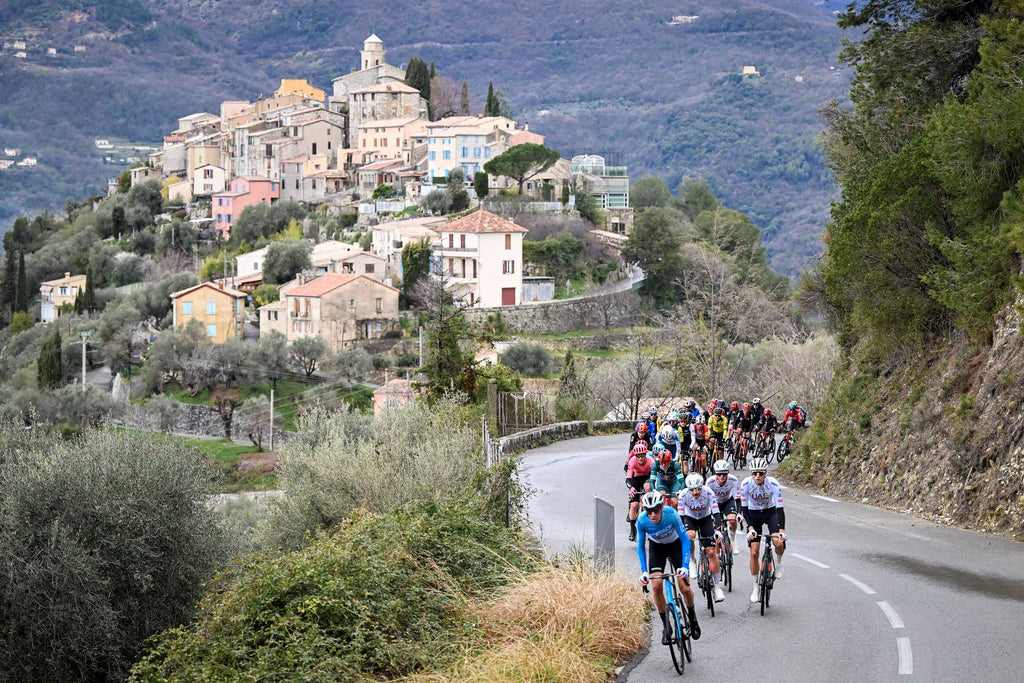The triumphant arrival of Matteo Jorgenson as the winner of the 2024 edition of Paris-Nice on the Promenade des Anglais was not the first time that Americans have left a deep mark on the Riviera city. A hundred years ago, swaggering Yankees flush with the cash that was blowing through the Roaring Twenties looked for places to spend it and the rich, the cosmopolitan, the adventurous and the louche gravitated to the Mediterranean. As the journalist and historian Mary Blume wrote in her book Côte d’Azur: Inventing the French Riviera, “The Americans came with their swinging gait, their jazz records, their sweet corn and new canned soups, their way of making the impossible look easy, and above all the briefly contagious national mood of expectation.”
There was a similar American national mood of expectation on the stage eight start line in Nice, with one short day of racing to go in the hills north of the city, and it was centred around yellow jersey Brandon McNulty and white jersey Jorgenson, only four seconds behind after McNulty faltered on the summit finish at La Madone d’Utelle the previous day. The sunny optimism of the American tourists a century before, however, was not reflected in the mood of the peloton as they contemplated one final chilly, soaking day in the saddle at the end of a week of inclement weather. As the rain that had followed the peloton near enough all the way across France for a week hammered down, grim-faced riders layered up and squeezed into their waterproof jackets, reflecting the observation of Sylvia Plath, another North American expat who made a temporary home in Nice, of the walkers on the Promenade des Anglais: “Everywhere, little black-clad people walk along the sparkling Sunday morning pavement.” Only on this Sunday morning, the black-clad people were shivering cyclists, and the pavement was anything but sparkling.
McNulty had spent almost half the race to this point in the overall lead; however there was a gathering momentum around his compatriot that was starting to look like inevitability. Jorgenson has made his home in Nice, and is in the first few months of riding for his new team, Visma-Lease a Bike. Visma are the pre-eminent stage racing team of the moment; Jorgenson is a rider who has been improving greatly in the last couple of years, partly from a well-publicised strategy of self-funding training camps and hiring personal nutritional support. Matteo Jorgenson joining a team like Visma, who currently look like the smartest, and strongest, guys in the room, has turned out to be a storm as perfect as the one that spent this past weekend sitting over the Riviera. And when Remco Evenepoel attacked mid-stage on the Côte de Peille, Jorgenson was the only rider strong enough to go with him. The pair were joined for a while by Alexandr Vlasov, but the Russian was dispatched on the final climb of the Col des Quatre Chemins and the spoils were divided in the traditional way: stage win for Evenepoel, along with second overall, GC win for Jorgensen in his adopted home city.
Jorgenson won Paris-Nice because he was about as strong as Evenepoel, maybe slightly less, but also because he rode more cleverly over the week, and also because Evenepoel was the favourite and favourites often get looked at to do the chasing. The Belgian got a 16-second head start over Jorgenson in the team time trial and squeezed another two seconds out of him in the last couple of hundred metres on Mont Brouilly on the fourth day of the race. But while these two set-piece stages were raced on strength, the grippy sixth stage across Provence to La Colle-sur-Loup, was more nuanced. Primož Roglič attacked with just over 30km to go, and Evenepoel chased. It took a kilometre for the Belgian to close down the Slovenian, and once the junction was made, Jorgenson attacked, and nobody immediately followed. He was joined not long afterwards by McNulty and Mattias Skjelmose, and again the chasing was left to Evenepoel. When the Belgian refused to do all the work, the gap ballooned to a minute, which more or less held to the end of the stage. Evenepoel had been racing Roglič, but if he’d known what we all know now, that the Slovenian was not at full strength at Paris-Nice, he might have raced Jorgenson instead. However, by the time Evenepoel realised who his main rival actually was, he was 40 seconds down on GC, and needed to take that time on what are essentially the American’s home roads.
While Evenepoel was choosing his enemies unwisely and finding allies hard to come by, Jorgensen was doing the opposite. Having made temporary and very useful allies out of McNulty and Skjelmose to put Evenepoel under pressure at La Colle-sur-Loup, he rode up La Madone d’Utelle with Evenepoel in order to put McNulty under pressure. McNulty managed to hold on to the race lead at the top, but he conceded 19 seconds to Evenepoel and Jorgenson, and with so much climbing to come on the final stage, the race had swung definitively towards Jorgenson. In winning Paris-Nice, his biggest ever result, and beating the hot favourite, Remco Evenepoel, Matteo Jorgenson made the impossible look easy.






























